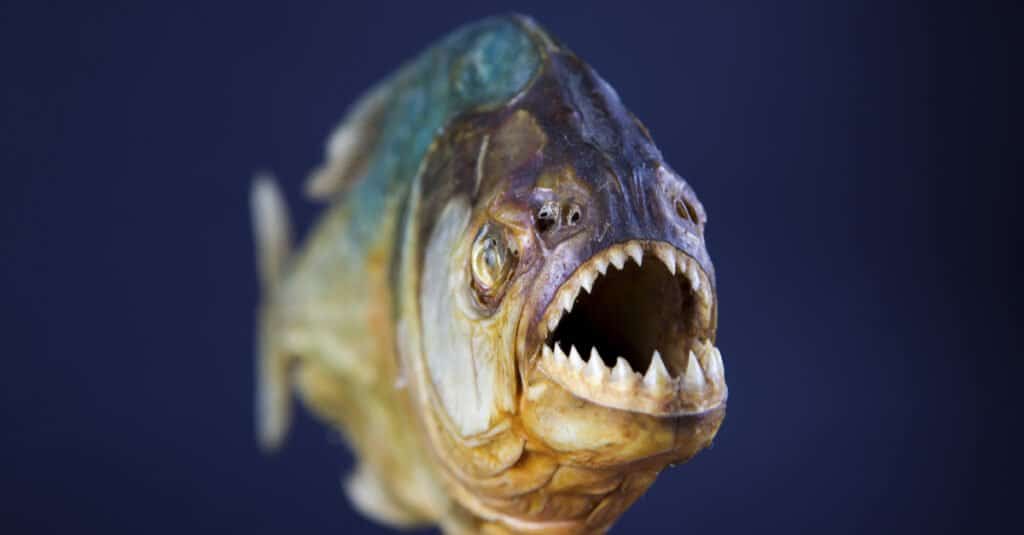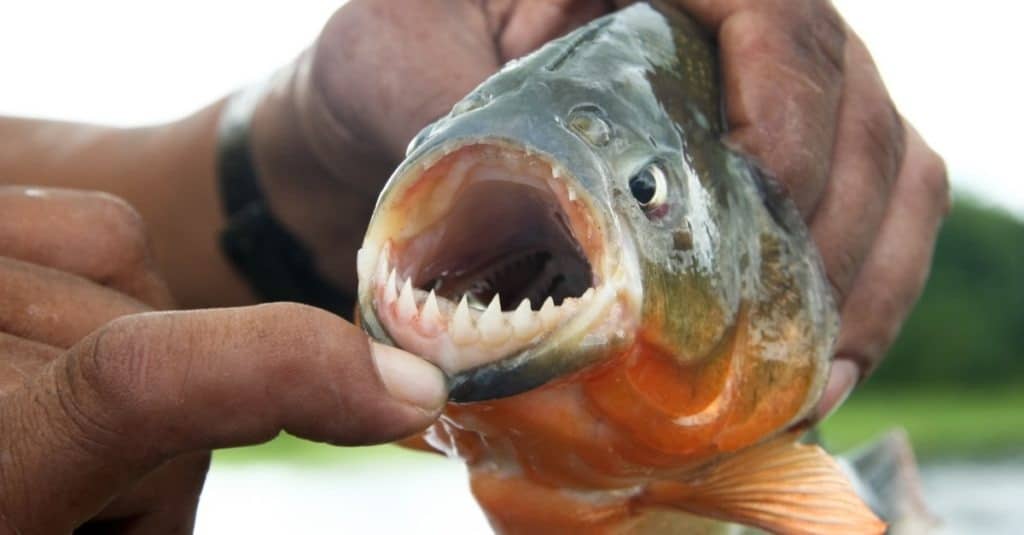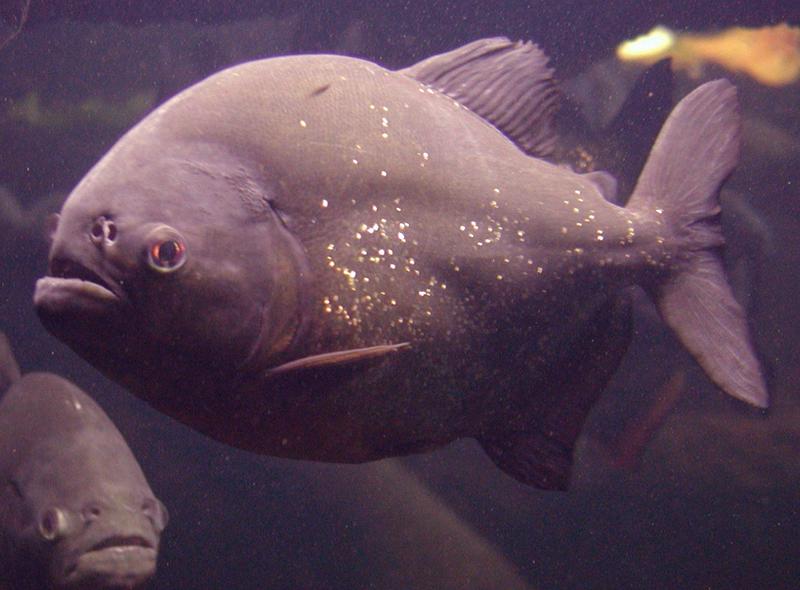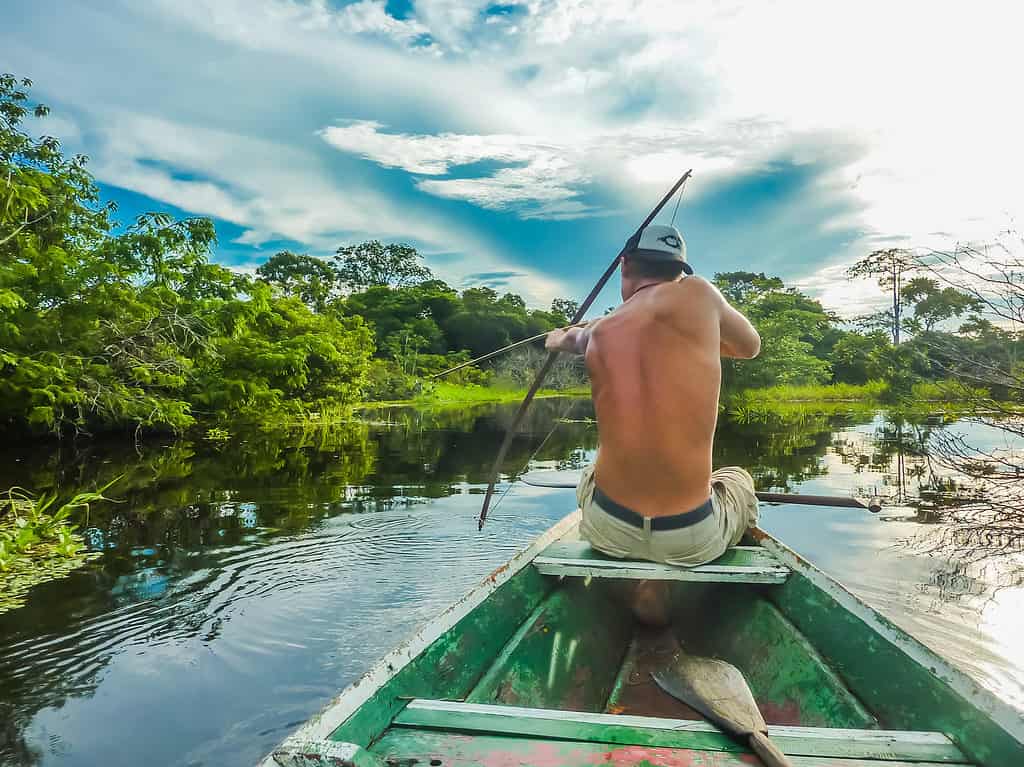Piranhas have a fearsome reputation thanks to their portrayal in books and movies. But, the fact is these toothy fish are not mindless man-eaters. There are many subspecies of Piranhas that occur throughout the world, but the biggest populations and most dangerous species can be found in South America. So, before getting into the water, read this article about the seven countries and rivers where the most piranhas live.
1. Amazon River

Some piranhas have terrible reputations and aggressive behavior, like the black piranha and red-bellied piranha.
©simongee/Shutterstock.com
The Amazon River is home to around 20 species of piranha. However, only around four or five species are dangerous. In fact, most species of piranha are harmless and placid. But, some piranhas have terrible reputations and aggressive behavior, like the black piranha and red-bellied piranha. The biggest species in the Amazon River is the Black piranha, measuring 12 inches long. While this river is their main habitat, they are also present in Brazil, in rivers like the Orinoco and Guianas. These fish are extremely dangerous. For example, it would take 5 min for 300 to 500 piranhas to eat all the flesh of a 176-pound human. However, these fish won’t usually attack people or other large animals unless they are threatened or smell blood.
2. Orinoco River

There are around 16 species of piranha in the Orinoco River, including the black spot piranha or
Pygocentrus cariba. These piranhas can measure up to 11 inches, making them popular game fish.
©Julio duarte/Shutterstock.com
There are around 16 species of piranha in the Orinoco River, including the black spot piranha or Pygocentrus cariba. These piranhas can measure up to 11 inches, making them popular game fish. Black spot piranhas are carnivorous; their diet consists of fish, invertebrates, carrion, and other aquatic animals. However, they are known for their preference of their own kind. In fact, the name Cariba means cannibal.
3. Parana River

The Parana River is the 13
thlongest river in the world and the second longest in the Amazon basin. It flows through Paraguay, Brazil, Uraguay, and Argentina.
©Tatiana Belova/Shutterstock.com
The Parana River is the 13th longest river in the world and the second longest in the Amazon basin. It flows through Paraguay, Brazil, Uraguay, and Argentina. The Parana River originates in southern Brazil, where the Grande and Paranaiba Rivers collide. It snakes through 3032 miles until it empties into the Atlantic Ocean at the Rio de la Plata estuary. But are there any piranhas in this river? Due to its size and good conditions for breeding, many piranhas live in its waters. In fact, the Parana River is home to three species of piranha, the most predominant being the Speckled Piranha.
4. Sao Francisco River

The São Francisco River flows 1,677 miles east and north through humid, semi-arid areas, providing a lifeline to the state before emptying in the Atlantic Ocean.
©Alberto Loyo/Shutterstock.com
With a total length of 1,801 miles, the São Francisco River is the longest in Brazil. It originates from Minas Gerais, a state in Serra de Canastra. The São Francisco River flows 1,677 miles east and north through humid, semi-arid areas, providing a lifeline to the state before emptying in the Atlantic Ocean. One of the piranha species that inhabit this river is the Pygocentrus piraya, also known as the San Francisco piranha or piraya piranha. This species is very aggressive and has a reputation as a man-eating fish. However, it is an omnivore but can get very aggressive when hunting for live prey. Their aggressive nature and large size make them dangerous to humans. Attacks on humans from San Francisco piranhas are rare, as they prefer to feed on insects, small fish, seeds, and aquatic plant material.
5. Venezuela

Two of the Genera are omnivores that eat proteins and fruits, but the other two are mostly carnivorous and will only resort to fruits when there is no prey.
©Ewa Studio/Shutterstock.com
There are 13 species of piranha that coexist in the pools and streams of the Llanos region of Venezuela and Colombia. They are divided into four: Genera, Pygocentrus, Pygoporistis, Sereasalmus, and Pristobrycon. These piranhas differ in size, abundance, and body form. Two of the Genera are omnivores that eat proteins and fruits, but the other two are mostly carnivorous and will only resort to fruits when there is no prey. But piranhas are also scavengers that will feed off animals killed by something else. You will often find piranha bite marks on an aquatic animal that has died from natural causes or killed by something.
6. Argentina

While these piranhas travel in tight-knit groups, they don’t stay together forever. Some will leave to join other groups, especially if they are better suited to the new group.
There are approximately three species of piranha in Argentina: Pygocentrus nattereri, S. Marginatus, and Serrasalmus maculatus, who all inhabit the lower Paran River. The Serrasalmus maculatus inhabits ponds, primarily in small groups of around 20 individuals. While these piranhas travel in tight-knit groups, they don’t stay together forever. Some will leave to join other groups, especially if they are better suited to the new group.
S. Marginatus occurs in Paraguay, Brazil, Uraguay, and Argentina, inhabiting the Rio Parana and Rio Paraguay drainages. The Pygocenturs nattereri is also known as the red-bellied piranha. Most of these piranhas are native to South America, occurring in the Paraguay, Amazon, Essequibo, and Parana basins. Furthermore, they also like freshwater habitats, like the coastal rivers northeast of Brazil. They are abundant in this area, with plenty of freshwater to quench their thirst. Their diet primarily consists of worms, insects, fish, and crustaceans.
7. Brazil

While attacks are rare, in recent years, they have become a frequent problem in dammed areas of the streams and rivers of the State of Sao Paulo. For example, there were two recorded attacks in neighboring counties, where a total of 74 swimmers were bitten.
©Christopher Moswitzer/Shutterstock.com
The most populous species of piranha in the Pantanal (the largest wetland in Brazil) is the Red-bellied Piranha. While attacks are rare, in recent years, they have become a frequent problem in dammed areas of the streams and rivers of the State of Sao Paulo. For example, there were two recorded attacks in neighboring counties, where a total of 74 swimmers were bitten. Researchers believe the piranhas were defending their spawning territory or protecting their young. However, the attacks stopped when aquatic vegetation was removed and fine mesh nets were placed into the water.
The species that recently attacked bathers in Sao Paulo is the dark-banned or speckled piranha (Serrasalmus maculatus). They are diurnal predatory fish that live in small groups of approximately 20 individuals, but many are solitary. They prefer to inhabit calm areas of streams, ponds, and rivers. These piranhas usually bite people’s heels, toes, and fingers. Furthermore, it is common for fishermen to get bitten when handling hooked or netted piranha. The wound bleeds profusely because the piranha’s teeth tear through tissues, creating a crater-like injury.
Is it Safe to Swim in Paranha-Infested Rivers?
While attacks on humans do occur, they are rare, and most piranhas are weary of humans. These fish usually flee large moving animals. So, they see humans as a massive threat. In their eyes, you could be a river dolphin, crocodile, or caiman, all of which eat piranhas. Attacks on humans primarily occur in the dry season or during spawning because this is when these toothy fish are most aggressive or extremely hungry. This is because most of their diet disappears during the dry season., so their meat consumption increases.
The photo featured at the top of this post is © simongee/Shutterstock.com
Thank you for reading! Have some feedback for us? Contact the AZ Animals editorial team.







